
Any of these signs can signal that you’re drunk or what’s officially called “acute alcohol intoxication.” They usually wear off in a few hours after you stop drinking. In her time here, Karlie trained as a clinical supervisor and an Acudetox therapist. She has a passion for working with clients to help them develop a more profound sense of identity why is alcohol addicting to navigate depressive and anxious symptoms.
- Using alcohol during adolescence (from preteens to mid-20s) may affect brain development, making it more likely that they will be diagnosed with AUD later in life.
- Ashley and her colleagues recently published an article on substance use disorders and the general addiction liability theory in APIS’s journal, Clinical Psychological Science.
- Fortunately, our team here at Soba Recovery has more than 30 years of combined experience treating addiction.
- This process happens every time someone consumes alcohol, and happens more intensely as more alcohol is consumed.
What Are the Benefits of Not Drinking Alcohol?

And toward the end of graduate school, I Sober living house became increasingly interested in quantitative methods and the ways that quantitative methods can be used to improve psychiatric classification. I shifted my focus into the space of addiction on my post-doc. I spent five years at University of Missouri as a postdoc and research professor, where I moved away from studying classification of personality disorders and toward psychopathology more generally.
A Root Cause of Addiction
Ultimately, alcohol addiction is caused by the effect alcohol has on the brain and the reinforcing cycle it creates. The brain craves more alcohol with each drink due to its interaction with the substance. This can lead to a cycle that makes it challenging to quit drinking. The brain undergoes chemical changes when exposed to alcohol, which is why it has this effect. Unlike cocaine or heroin, alcohol is widely available and accepted in many cultures.
of Americans Would Be Uncomfortable With Provider Relying on AI in Their Own Health Care

It’s good that people don’t present with 7, 8, 9 drug use disorder diagnosis. Most people do not diagnose with a substance use disorder at all. Beyond two, That’s just statistically what one of my old advisors would call decimal dust, meaning it’s just not represented in the population.

What are the symptoms of alcoholism?
It activates reward circuits in the brain, leading to a feeling of euphoria, which can be habit-forming. It also interacts with neurotransmitter systems in stress and reward circuits, which can lead to brain function changes over time and contribute to alcoholism. Some people have a predisposition to alcoholism due to genetic factors. Expressly, some people’s brains release more pleasure chemicals in response to alcohol.

- If general addiction liability turns out to be a robust, well-supported phenomenon I think it will cause us to shift the way that we treat folks.
- Really, everyone is trying to describe really remarkably varied or heterogeneous forms of psychopathology in terms of unitary dimensions.
- In 2023, Jordan joined the clinical team at AspenRidge Recovery.
- The brain works hard to deal with its presence and will change its structure to welcome it back time and time again.
- Is it considered to be more addictive because of its presence in society?
- Still, 58% say it won’t have any impact on the amount they drink.
I knew I wanted to shift away from studying that, and so I took on a post-doc that would challenge me to learn something new. Immediately, I was struck by the heterogeneous nature of substance use disorders. I mean, even just week one of my post-doc, I was like, Whoa, how can we take this collection of symptoms and call this one thing? I think I projected a little bit of my interest in classification in heterogeneity onto addiction and hit the ground running by focusing on sources of heterogeneity in addiction.
- With methadone, for instance, being a way to taper people off of prescription opioids, as just one example.
- Drawing from her background in local improv groups, she infuses sessions with laughter and humor, fostering a non-judgmental space for clients.
- She is a trauma-informed clinician who prioritizes the relationship between clinician and client.
- The temporary “high” resulting from alcohol use can provide a sense of relaxation and pleasure, which helps people cope with stressful situations.
Early studies suggest that GLP-1s may be effective in treating opioid, alcohol and nicotine addiction. In one small study of patients with opioid use disorder, a GLP-1 medication reduced their cravings for opioids by 40% over three weeks. As an added advantage, GLP-1s are not themselves addictive and don’t trigger withdrawal.
It’s just a remarkably simplistic approach to an extremely complicated set of phenomena. My graduate research made the point to the extent possible that we really can’t think of any given personality disorder as one thing. They contain many different dimensions that in concert produce what looks like a psychopathic personality, for instance.